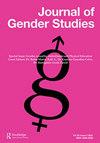酷儿亲属关系:种族、性别、归属、形式
IF 1.5
3区 社会学
Q2 SOCIAL ISSUES
引用次数: 3
摘要
因此,这一章将卡西诺和贝森-卡西诺试图强调的问题的严重性带回家。他们引用了2018年美联社VoteCast的调查,在调查中,男性被问及他们是否是同性恋,以及他们是否拥有枪支。研究结果显示,“当询问男性是否是同性恋时,4%的人会突然决定拥有原本不会拥有的枪支”(第80页)。卡西诺和贝森-卡西诺得出结论,“关于性的问题可以成为威胁”(第80页)。这个经过深思熟虑和令人不安的章节旨在提醒读者为什么这项研究及其发现是最重要的和当代的。《上帝、枪支和色情》考虑了性别如何渗透到生活的其他方面,以及政治和性骚扰。深入研究这本书,发现并不令人惊讶:受到威胁的男性更有可能转向极端的宗教意识形态,拥有枪支,观看贬低女性的色情作品,以维护权力和男子气概。卡西诺和贝森-卡西诺在这里首次考虑了公共和私人行为的差异。虽然枪支持有和色情内容的使用不能肯定地解释,因为它们取决于受访者的自我报告,但研究人员分析了全州和全国的数据,以检验这些补偿行为“支持否则受到威胁的男性身份”的程度。(第87页)在最后一章“交替的男性气质”中,Cassino和Besen-Cassino没有进一步探索受社会影响的行为,而是选择研究父亲在经济压力下如何采取积极的补偿行为。作者从网上(讨论板和博客)的叙述中探索了许多观点,这些观点表明,在经济衰退后,男性利用他们在家里的地位“做了很多家务”(第113页),并“为我的女儿树立了良好的行为榜样”(第116页)。对这些男人来说,这些行为就像拥有一把枪一样增强了他们的男子气概。这本迷人而及时的书吸引了所有学科的读者,包括那些超越性别研究领域的读者。卡西诺和贝森-卡西诺分析了一系列行为及其与性别威胁的关系,揭示了男性补偿行为如何威胁当代社会。虽然很大程度上归因于经济背景,在某种程度上没有考虑到其他社会压力,但这篇文章表明,在当代美国社会,男性气概是如何受到威胁的。尽管这本书的基调总体上是悲观的,但作者的结论是积极的:“男子气概正在改变,它是可适应的”(第140页),它可以以一种有利于个人和更广泛的美国社会的方式表达。本文章由计算机程序翻译,如有差异,请以英文原文为准。
Queer kinships: race, sex, belonging, form
and as a result this chapter brought home the magnitude of the issue that Cassino and Besen-Cassino seek to underline. They cite the 2018 AP VoteCast survey, in which men were asked if they were homosexual and if they owned a gun as part of a survey. The findings show that ‘asking men if they’re gay leads to 4% of them suddenly deciding they have guns that they otherwise would not have had’ (p. 80). Cassino and Besen-Cassino concluded that ‘questions about sexuality can serve as threats’ (p. 80). This well-considered and disturbing chapter serves to remind the reader why this study and its findings are paramount and contemporary. ‘God, guns and pornography’ considers how gender permeates other aspects of life as well as politics and sexual harassment. Having ventured this far into the book, the findings become unsurprising: men under threat are more likely to turn to extreme religious ideologies, own a gun and view pornography that degrades women to assert power and masculinity. Cassino and Besen-Cassino consider the divergence in public and private behaviours for the first time here. Whilst gun ownership and pornography usage cannot be certainly accounted for as they depend on the interviewees’ self-reporting, state-wide and national data are analysed to examine the extent that these compensatory behaviours ‘bolster an otherwise threatened masculine identity’. (p. 87) In the last chapter, ‘Alternate masculinities’, Cassino and Besen-Cassino defer from exploring further socially influenced behaviours, choosing instead to examine how fathers adopt positive compensatory behaviours when under economic stress. The authors explore numerous viewpoints derived from online narratives (discussion boards and blogs) that show men using their position in the home after the recession to ‘do a lot of things around the house’ (p. 113) and ‘to model good behaviour for my daughter’ (p. 116). To these men, these behaviours reinforce their masculinity as much as owning a gun. This fascinating and timely book appeals to readers of all disciplines, including those beyond the gender studies realm. Cassino and Besen-Cassino analyse a range of behaviours and their relationship to gender threat, to uncover how masculine compensatory behaviours threaten contemporary society. Although much weight is attributed to economic context, to some extent leaving other societal pressures unconsidered, the text serves to illustrate how masculinity is perceived to be threatened in contemporary American society. Despite the book’s generally pessimistic tone, the authors conclude on a positive note: ‘masculinity is changing, it’s adaptable’ (p. 140) and it can be expressed in a way that benefits the individual man, as well as wider American society.
求助全文
通过发布文献求助,成功后即可免费获取论文全文。
去求助
来源期刊

Journal of Gender Studies
Multiple-
CiteScore
4.40
自引率
0.00%
发文量
52
期刊介绍:
The Journal of Gender Studies is an interdisciplinary journal which publishes articles relating to gender from a feminist perspective covering a wide range of subject areas including the Social and Natural Sciences, Arts and Popular Culture. Reviews of books and details of forthcoming conferences are also included. The Journal of Gender Studies seeks articles from international sources and aims to take account of a diversity of cultural backgrounds and differences in sexual orientation. It encourages contributions which focus on the experiences of both women and men and welcomes articles, written from a feminist perspective, relating to femininity and masculinity and to the social constructions of relationships between men and women.
 求助内容:
求助内容: 应助结果提醒方式:
应助结果提醒方式:


